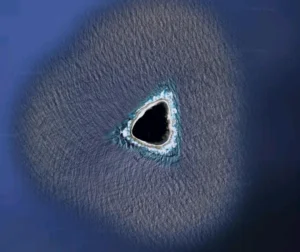We complain about the weather daily. Some of us take our little blue planet for granted, although it’s a perfect place for human life. The weather systems on other planets are volatile and would undoubtedly make us reconsider grumbling about Earth’s minor inconveniences.
Jupiter
Jupiter is called the king of the planets for a few reasons: It’s named after the Roman god of the sky, it is massive, and it has incredibly powerful turbulent weather.
Jupiter’s atmosphere consists of 89.6% hydrogen, 10.1% helium, and 0.3% methane, with various trace gases such as water, ammonia, and hydrogen sulfide. Below the atmosphere are three layers of clouds. The top layer is composed of ammonia ice, the second is made of ammonium hydrogen sulfide ice, and the third is made mostly of water. Clouds and winds travel at incredible speeds and storms can last for several hundred years.

Jupiter’s Great Red Spot. Photo: NASA/Juno Mission
Of course, we cannot talk about Jupiter without mentioning its defining feature: the Great Red Spot (GRS). The GRS is a storm that never sleeps. It was first observed by astronomers in the 1600s and is potentially far older. It is over 40,000km across and 500km deep. Over the years, it has changed in size, yet it remains persistent, rotating in an anticlockwise direction with winds of up to 434kph.
In Jupiter’s cloud tops, lightning storms are present. According to NASA’s Heidi Becker, the head of the Juno probe mission to Jupiter, these flashes of lightning are believed to be created by the chemical reaction between water crystals and ammonia vapor.
Jupiter is also prone to odd kinds of precipitation. Because of the high amounts of helium in its atmosphere, it probably rains helium. On top of that, the previously mentioned reaction of water crystals and ammonia creates slushy hailstones nicknamed “mushballs”, which can weigh up to a kilogram.
However, the weirdness doesn’t stop there. Scientists at Jet Propulsion Laboratory suggest that Jupiter could sometimes rain diamonds. Lightning has the potential to shock the methane in the atmosphere, creating solid carbon. As it falls into Jupiter’s depths, it could turn from graphite into diamond.
Titan
Titan, one of Saturn’s moons, is not a planet, but it does have some bizarre weather. It is the only moon in our planetary neighborhood with a considerable atmosphere. The atmosphere is extremely dense, consisting of 95% nitrogen and 5% methane.
Astronomers have found that Titan is abundant in lakes and oceans composed entirely of hydrocarbons. You might wonder what fills these bodies of water. Methane rain solves the problem!

Illustration of Titan’s hydrocarbon lakes. Photo: Jurik Peter/Shutterstock
It is believed that methane acts in a cycle, much like Earth’s water cycle. Titan is home to cryo-volcanoes that spew out water, ice, and gases such as methane. This replenishes the methane in the atmosphere, which condenses into clouds and releases methane rain. The rain accumulates in lakes and other bodies on the surface.
Like Earth, Titan has seasons. It is believed that hurricanes could form during its rainy season.
Uranus
Some have the gall to suggest that Uranus is the most boring planet in the Solar System. While it is distant, cold, and a bit of an oddball, it has many fascinating features.
Uranus is an ice giant, with an atmosphere composed of 82.5% hydrogen, 15.2% helium, and 2.3% methane, ethane, and acetylene. Like any other planet, right? Wrong. Its topsy-turvy 98° axis tilt is the reason for a lot of its crazy weather.
The 98° tilt is thought to be a result of a collision between Uranus and an Earth-sized object. This impact has subjected Uranus to extreme seasons, where one pole spends 42 years in complete darkness and the other in total sunlight. When the dark pole finally gets sun, the small amount of heat is enough to create storms the size of whole continents. Winds on Uranus can reach 900kph.

Uranus. Photo: NASA
Like Jupiter, there is a chance that Uranus has diamond rain. Scientists believe that as hydrocarbons are broken down, the carbon atoms turn into diamonds under high pressure as they fall into the planet.
Neptune
Neptune may be distant, but it sure is active. Like Uranus, it has an atmosphere made of hydrogen (79.5%), helium (18.5%), and methane (2%). However, it stands out as the windiest planet in the Solar System. Winds can exceed 2,000kph!
Neptune’s brilliant blue color comes from layers of frozen methane clouds, ammonia, sulfides, and water. Cirrus clouds are the most common cloud type. A persistent band of them traverses the planet every 16 hours (a Neptunian day).

An image of Neptune from Voyager 2. Photo: NASA/JPL-Caltech
Neptune is prone to dark and white spots, which are various types of storm. The Great Dark Spot, which has disappeared recently, had winds of 2,400kph and was the size of Earth!
The crazy weather isn’t driven by the sun. At -201°C, Neptune is beyond frigid. Apparently, it is internal heat that drives the weather, feeding off itself.
Exoplanet HD 189733 B
As we venture from the comfort zone of our familiar planetary family, we see how strange weather can get. HD 189733 B is a ‘hot Jupiter’ exoplanet, meaning it is roughly similar to Jupiter in size, with short periods of orbit.
While water, oxygen, and carbon dioxide are present, the planet remains deadly. It has winds several times stronger than Neptune, reaching 8,700kph. As for rain, the raindrops are hot, molten silicate particles (essentially glass) that are whipped across the planet.

An artist’s illustration of HD 189733 B. Photo: NASA/CXC/M. Weiss
Exoplanet Hd 80606 B
This is another hot Jupiter-like planet that has an exploding atmosphere. You heard that right.
This planet has an orbit of 114 days, and that takes it dangerously close to its star. When this happens, it takes as little as six hours for all hell to break loose. Winds can reach 17,400kph, the temperature soars hundreds of degrees, and radiation spikes. Scientists describe these epic changes as “shockwaves”.

Atmospheric simulation of the exoplanet. Photo: NASA / JPL-Caltech / J. Langton (Univ. of California, Santa Cruz)
Exoplanet HAT P-7B
HAT P-7B has extreme temperatures of up to 1700°C, and drastic wind changes. But its most interesting feature is the presence of corundum in its clouds. This is the mineral responsible for creating sapphires and rubies. We don’t know if actual gemstones rain down from the sky, but further exploration might confirm it in the future.

Artist’s illustration of HAT P-7. Photo: University of Warwick/Mark Garlick






